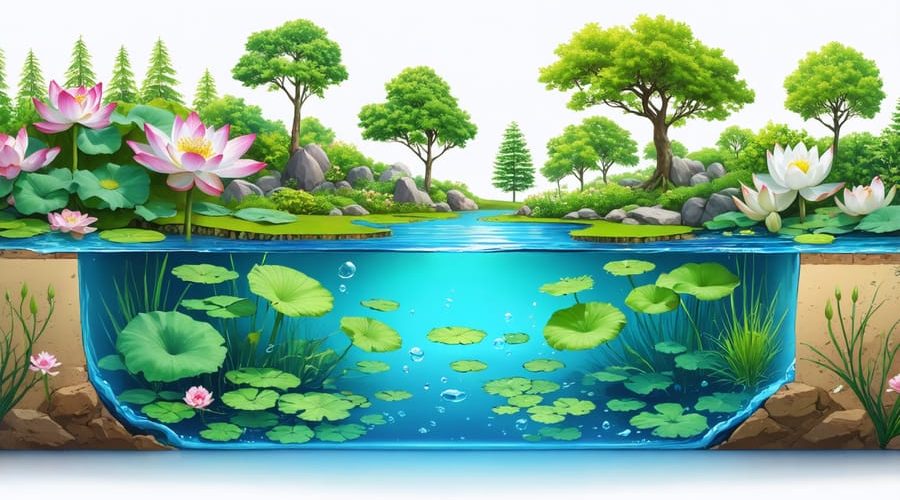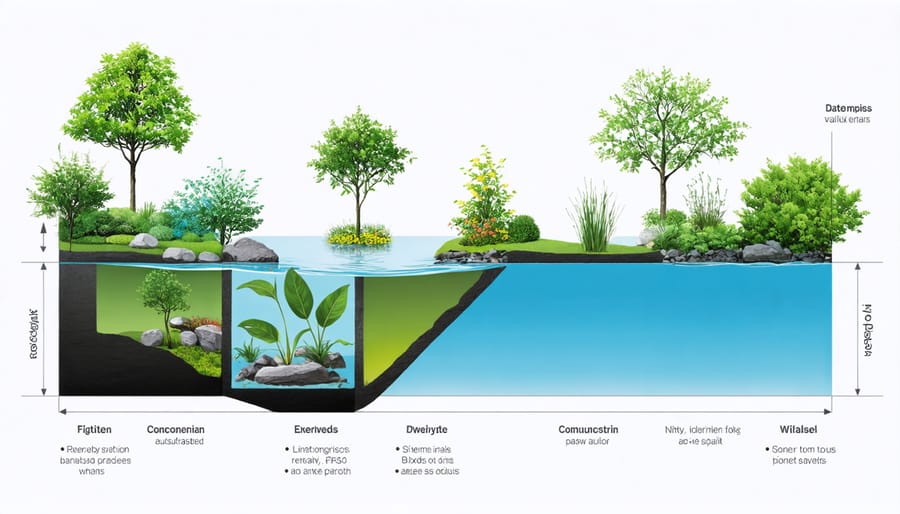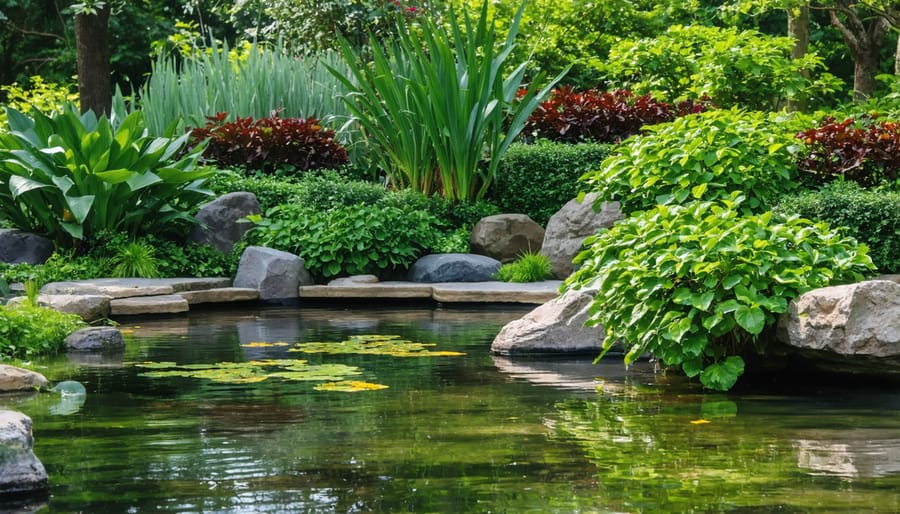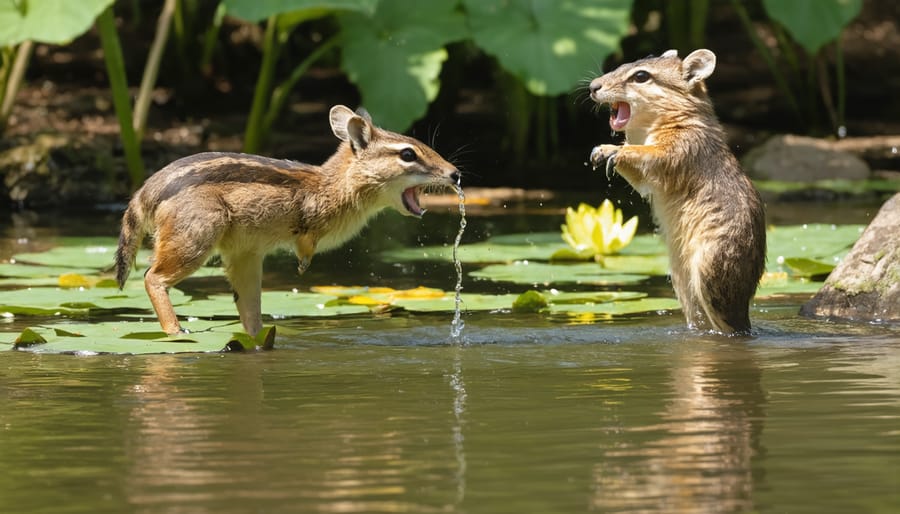
Create Your Dream Water Garden: Perfect Plant Combinations for Every Zone
Transform your backyard into a thriving aquatic paradise by building a water garden that perfectly balances beauty and functionality. Create distinct planting zones – shallow margins (0-6 inches), deep margins (6-12 inches), and open water areas (12+ inches) – to support diverse aquatic plant communities. Select native water lilies, lotus, and marginal plants that complement each other’s blooming seasons, ensuring year-round visual interest while naturally filtering the water. Position oxygenating plants like hornwort and anacharis to cover 60-70% of the water’s surface, maintaining crystal-clear water quality and providing essential habitat for beneficial wildlife.
The magic of water gardening lies in its ability to transform ordinary spaces into enchanting ecosystems. Whether you’re designing a small container water garden or planning an elaborate pond system, the right plant combinations will create a self-sustaining environment that delights the senses and supports local biodiversity. With proper planning and plant selection, your water garden will become a vibrant centerpiece that requires minimal maintenance while providing maximum enjoyment throughout the seasons.

Understanding Water Garden Zones
Marginal Plants Zone
The marginal zone, typically 0-6 inches deep, creates a smooth transition between your garden and deeper water areas. This shallow shelf is perfect for water garden plants that enjoy having “wet feet” while keeping their crowns above water. Popular choices include iris, rushes, and sedges, which add vertical interest and natural beauty to your pond’s edges. These plants not only create an attractive border but also provide essential cover for wildlife and help filter excess nutrients from the water. When planting this zone, space plants about 2 feet apart to allow for growth, and use a heavy clay-based soil mix in planting baskets to prevent soil from washing away while keeping plants anchored.
Deep Water Zone
The deep water zone, typically 12-30 inches deep, is home to some of the most dramatic aquatic plants. Water lilies are the stars here, with their floating leaves and stunning blooms in shades of pink, white, yellow, and purple. Hardy varieties like Nymphaea ‘Attraction’ and ‘Colorado’ thrive year-round, while tropical varieties offer more exotic flowers but need winter protection.
Other deep-water favorites include lotus plants, with their magnificent flowers rising above the water on tall stems, and submerged oxygenators like hornwort that help maintain water quality. When planting, use specially designed aquatic baskets filled with heavy topsoil, topped with gravel to prevent soil from floating away. Position plants so their crowns are 6-12 inches below the water surface, allowing them to grow toward the light while keeping their roots cool.
Bog Garden Zone
A bog garden zone creates a stunning transition between your pond and traditional garden beds. These moist areas are perfect for moisture-loving plants that add color and texture to your water feature. Popular choices include Japanese iris, marsh marigolds, and cardinal flowers, which thrive in consistently damp soil. Place taller plants like joe-pye weed and swamp milkweed at the back, with shorter specimens like forget-me-nots and creeping jenny in front. Consider adding pitcher plants or sundews for unique interest – these carnivorous plants naturally help control insects while adding conversation-worthy appeal. When designing your bog garden, ensure the soil stays consistently moist but not waterlogged, and mulch with pebbles or river rock to maintain moisture and create a natural look.
Complementary Plant Combinations
Height and Structure Pairings
Creating visual interest in your water garden starts with understanding height layering. Think of your water garden as a natural theater, with different plants playing roles at various levels. Start with tall, dramatic plants like cattails or iris at the back or center, reaching heights of 3-4 feet. These create an eye-catching backdrop and provide structure throughout the seasons.
In front of your tall plants, position medium-height varieties like marsh marigolds or pickerelweed, typically growing 1-2 feet tall. These bridge the gap between tall and short plants while adding splashes of color. For the foreground, incorporate low-growing plants like creeping jenny or water forget-me-nots that spread horizontally rather than vertically.
Don’t forget about underwater depth variations! Float water lilies on the surface while allowing submerged plants like hornwort to create layers beneath. This multi-level approach not only looks natural but also provides hiding spots for pond wildlife.
For the best visual impact, follow the rule of thirds: dedicate roughly one-third of your space to each height category. Mix textures and leaf shapes within each level – pair feathery foliage with broad leaves, or combine spiky forms with rounded ones. Remember to consider seasonal changes; some plants will die back in winter, so include evergreen varieties for year-round structure.

Seasonal Bloom Combinations
Creating a water garden that delights throughout the year requires thoughtful planning and strategic plant combinations. Start with early spring bloomers like marsh marigolds and water irises, which bring vibrant yellows and purples when most gardens are just waking up. As spring transitions to summer, incorporate water lilies in various colors – they’ll provide stunning blooms from June through September.
For summer drama, combine lotus flowers with pickerelweed, whose tall purple spikes create exciting vertical interest. Edge these with the delicate flowers of water forget-me-nots for a layered look. Late summer brings the golden hues of bog bean and the striking purple of swamp loosestrife.
Don’t forget about foliage! Mix plants with different leaf shapes and textures. The arrow-shaped leaves of arrowhead plant contrast beautifully with the round pads of water lilies. For fall interest, consider Japanese water iris, whose foliage turns amber, complementing the purple flowers of water mint.
Winter interest comes from ornamental grasses like variegated sweet flag, which maintains its structure even in cold months. Include evergreen marginals like marsh fern to ensure year-round greenery. Remember to position plants at their appropriate depths and consider their spread to maintain harmony as your garden matures.
By planning these seasonal combinations, you’ll create a dynamic water garden that offers something special in every season.
Color Harmony Groups
Creating a visually appealing water garden starts with understanding color harmony. Think of your water garden as a living canvas where different plant varieties work together to create stunning visual effects. Start with a base of cool colors like blues and purples from water lilies and iris, which naturally complement the water’s surface and create a sense of depth.
For vibrant contrast, incorporate warm yellows and oranges through marsh marigolds or cannas near the water’s edge. These bright pops of color draw the eye and create exciting focal points. Consider the classic combination of purple pickerelweed with yellow flag iris for a striking display that blooms throughout the season.
Layer your color schemes vertically, starting with floating plants on the water’s surface, then moving up through marginal plants to taller background specimens. White flowering plants like arrowhead or water hawthorne can serve as natural brightness adjusters, helping to blend different color groups together.
Remember that foliage colors are just as important as flowers. Mix silver-grey plants like water sage with deep green rushes and the burgundy leaves of certain water lilies. For year-round interest, include plants with colorful stems or seed heads that provide visual appeal even after blooming ends.
When planning your color combinations, consider bloom times to ensure continuous color throughout the growing season. Group early, mid, and late-season bloomers together to maintain visual interest from spring through fall.

Plant Selection for Wildlife Support
Fish-Friendly Varieties
Creating a fish-friendly environment in your pond starts with selecting the right plants. When choosing pond fish, it’s essential to provide them with adequate shelter and natural hiding spots. Submerged plants like hornwort and anacharis offer excellent protection for smaller fish while helping maintain water quality.
Floating plants such as water lilies and lotus provide shade, which is crucial for fish during hot summer days. Their broad leaves create natural cooling zones and offer protection from predatory birds. For additional security, consider adding marginal plants like rushes and irises around the pond edges, where fish can dart between the stems when feeling threatened.
Water smartweed and pickerelweed are particularly beneficial as they grow dense underwater root systems that serve as natural fish nurseries. Young fry can safely develop among these underwater forests, protected from larger fish and other predators.
Remember to maintain a balance between open swimming areas and planted zones. A good rule of thumb is to cover about 60% of your pond’s surface with plants, leaving plenty of space for fish to move freely. This arrangement creates a natural ecosystem where fish can thrive while enjoying the benefits of plant-provided shelter, oxygen, and natural food sources.
Pollinator-Attracting Options
Creating a vibrant pollinator-friendly water garden adds another layer of life and movement to your aquatic sanctuary. Cardinal flowers, with their brilliant red blooms, are irresistible to hummingbirds and butterflies. Plant these along the margins of your pond where their roots can stay moist while their flowers tower above.
For shallow water areas, consider marsh marigolds and pickerelweed. Their bright yellow and purple blooms not only provide nectar for bees but also create stunning reflections on the water’s surface. Swamp milkweed is another excellent choice, serving as a vital host plant for monarch butterflies while tolerating wet conditions perfectly.
Don’t forget about fragrant options like sweet flag and water mint, which attract beneficial insects while releasing pleasant aromas when brushed against. For late-season interest, Joe-Pye weed and swamp sunflowers provide essential food sources for pollinators preparing for migration or winter.
Consider creating “landing pads” near your water feature using flat stones where butterflies can rest and bask in the sun. Clustering pollinator-friendly plants in groups of three or five makes them more visible to passing insects and creates a more impactful display. Remember to include some native species in your selection, as these are particularly attractive to local pollinators and require less maintenance once established.
Maintenance Considerations
Growth Rate Management
Managing growth rates in your water garden is like conducting an orchestra – you need to balance fast and slow-growing plants to create harmony. Fast-growing species like water hyacinth and duckweed can quickly take over if left unchecked, while slower growers like water lilies need time and space to establish themselves.
To achieve this balance, start by grouping plants with similar growth rates together. Place rapid growers in contained areas or floating baskets that make regular pruning easier. For every fast-growing plant you add, include two or three slower-growing species to maintain equilibrium.
A helpful strategy is to implement the “rule of thirds” – dedicate one-third of your water garden to fast growers, one-third to moderate growers, and one-third to slow-growing species. This creates natural barriers that help control aggressive plants while giving slower specimens room to thrive.
Monitor your plants weekly during the growing season. Trim back fast growers before they become overwhelming, and protect slower-growing plants by ensuring they receive adequate light and nutrients. Consider using physical barriers like pond baskets or sections divided by rocks to keep vigorous species from encroaching on their slower neighbors.
Remember that seasonal changes affect growth rates differently. Spring usually brings rapid growth to fast-growing species, while fall and winter naturally slow things down. Adjust your maintenance schedule accordingly to maintain the perfect balance throughout the year.
Seasonal Care Requirements
Your water garden’s needs change with the seasons, and proper seasonal water garden maintenance is essential for healthy plant growth. In spring, focus on dividing and replanting marginal plants as they begin to show new growth. Remove any dead foliage and check water levels as rainfall patterns change.
Summer brings rapid growth and requires regular fertilization of heavy feeders like water lilies. Keep floating plants in check by removing excess growth, which can overwhelm smaller ponds. Monitor water levels more frequently during hot weather and top up when necessary.
Fall maintenance involves removing fallen leaves before they sink and decompose. Begin reducing fertilization as plants prepare for dormancy. Trim back marginal plants to prevent decay in the water during winter months.
Winter care varies by climate. In mild areas, continue basic maintenance while reducing feeding. In colder regions, move tender tropicals indoors, and install pond netting to catch falling leaves. Deep-water plants like water lilies can remain in the pond if they’re below the freeze line, while shallow-water plants might need protection or indoor storage.
Remember that different plant groups have varying needs – floating plants require minimal winter care, while bog plants might need mulching for protection. Adjust your care routine based on your specific plant selection and local climate conditions.
Creating your own water garden is an exciting journey of discovery and creativity. By understanding the different planting zones and combining various aquatic plants, you can develop a thriving ecosystem that brings beauty and life to your outdoor space. Remember that successful water gardens aren’t built in a day – start small, observe what works, and gradually expand your collection. Don’t be afraid to experiment with different plant combinations while keeping maintenance requirements in mind. Whether you’re drawn to the elegant simplicity of water lilies or the vibrant energy of marginal plants, your perfect water garden awaits. Take inspiration from the guidelines we’ve shared, but feel free to adapt them to your unique vision and garden conditions. The joy of water gardening lies in creating your own peaceful oasis that evolves and flourishes with each passing season.
